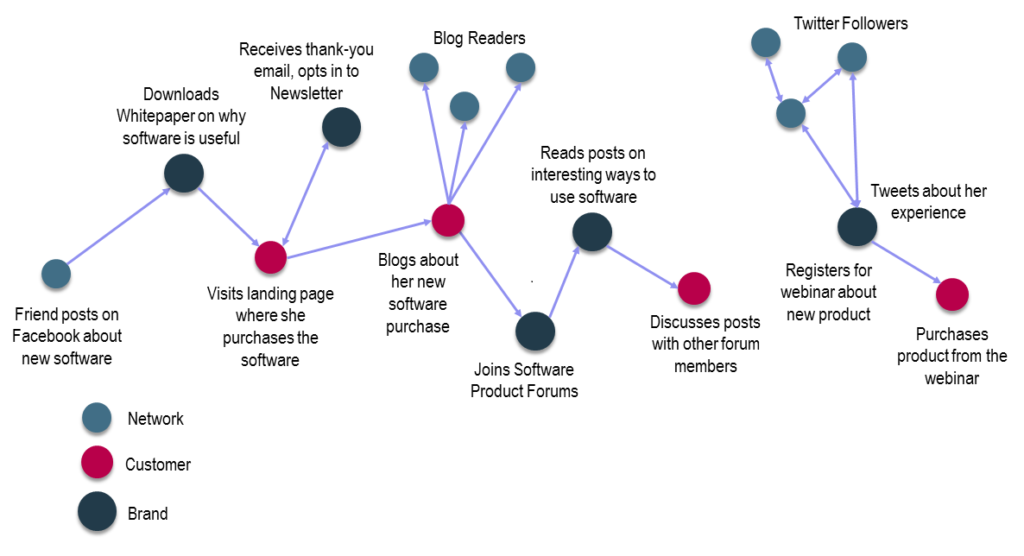Tracing The Customer Journey: Lessons from Deep Linking

One of those reassuring little white lies we tell ourselves as marketers is this: People make linear decisions. It’s simpler to draw straight lines about people’s behavior, so to date we have typically pushed people through carefully scripted linear marketing processes.
But does that really reflect people’s actions and the ways they find information? Of course not. We all know it doesn’t really happen that way.
Here’s an example to illustrate a customer journey.

Figure 1. An example of a Customer Journey. It is often a chaotic process.
Given the complexity of the Customer Journey, how do marketers effectively track it?
For this problem, marketers can learn a lot from Mobile App Development and the concept of “Deep Linking.”
How Deep Linking is revolutionizing Mobile Apps
(and what marketers can learn from it)
In the context of mobile apps, deep linking refers to using a uniform resource identifier (URI) that links to a specific location within an app (e.g exampleApp://location/123456) instead of just launching the app (eg. exampleApp://).
There are 3 main benefits of Mobile Deep Linking that also have applications to content marketing:
1) See how customers are moving from app-to-app and make it easier to do so
For example, Google Maps not only provides directions and drive times but also offers integration with Uber, redirecting users right into the Uber app with estimated drive time and cost.
For Content Marketers: You want to see where your customers go after your initial point of contact. How do they move around? Do they register for your event, sign up for a newsletter, go to another post?
2) Easier to track where in-app purchases occurred
70% of mobile commerce occurs in-app*. Deep linking let’s you know where these purchases occurred. This can help improve revenue by driving users to these higher converting locations.
For Content Marketers: It is important to understand where your customers are converting in order to maximize marketing efforts. Are they converting on a particular channel/ article? Are Twitter followers more likely to become leads than Facebook? Marketers need to set up their tracking to be able to answer these questions.
3) Discover what parts of your app are most valuable to your customers
Deep linking let’s you discover which features of your app are worth advertising to prospects. Different features may appeal to different target markets. Deep linking allows for better segmentation and testing. For example, try deep linking to parts of your app and target different audiences on social media.
For Content Marketers: Not all content assets will resonate with your audience. If you can identify your best content assets and most fruitful channels, you can spend more of your marketing efforts there.
How Classifying your Content Marketing Helps You Discover Your Customer Journey
The equivalent of Deep linking for content marketers would be setting up tagging/ tracking on your URLs to give you more granular data about the customer journey. This requires you to set up a content classification, which is the process of describing and naming different variables in your marketing funnel (channel, content format, campaign, target audience, buying stage etc.). You would then tag each of your URLs with the correct classification (e.g. link 1; channel=Facebook, buying starge=awareness, content format=video, target audience=Women aged 35-55, etc)
Buying is a complex process with multiple stops, starts, and options. Each potential customer will move through the process in unique ways (although, in aggregate, demonstrating certain patterns of behavior).
By setting up your content classification and tracking ahead of time, you will be able to see these patterns of behavior much more clearly. By tracking your customer journey you can better understand their needs, and more accurately calculate the LTV (lifetime value) of each customer.
Why don’t marketing organizations track
their customer journey?
Three reasons:
1) Traditional marketing is structured around campaigns, not customers
The framework by which they understand marketing is not set up for a non-campaign world where they don’t control timelines and control only experiences. The so-called sales funnel, if that was ever an accurate metaphor, no longer looks even remotely like a funnel.
Companies tend to view the sales and marketing process as a systematic approach of 7-9 steps.The process, from the customer’s perspective, is nothing like that.
2) They view the marketing process in terms of pre-sale and post-sale
Marketers don’t measure a linked sequence of customer actions across all touch points yet; they still think in terms of pre-sale and post-sale, not a relationship that can last a lifetime.
3) They try to control the entire marketing process
Marketers have been determined to control the narrative rather than create digital touch points of content and experience, and then measure how people interact with those touch points. Human’s don’t always behave how you want them to, and your tracking needs to set up to measure how they naturally interact with your brand.
The marketing process is not linear nor static; it is dynamic, evolving and customized by the prospect and NOT the marketer. So, in order for the marketer to understand the ACTUAL buyer journey (versus the INTENDED buyer journey), the marketer needs to track the actual against the intended to gain insights and improve conversions going forward.
That is why it is so important to properly set up your tracking and content classification ahead of time. By setting up measurement beacons that customers interact with, marketers can understand what each digital customer narrative looks like.
To learn about How to Set up your Content Classification to better understand your customer’s buying journey download our guide here.
*source: http://venturebeat.com/2015/08/09/deep-linkings-big-untapped-potential/
